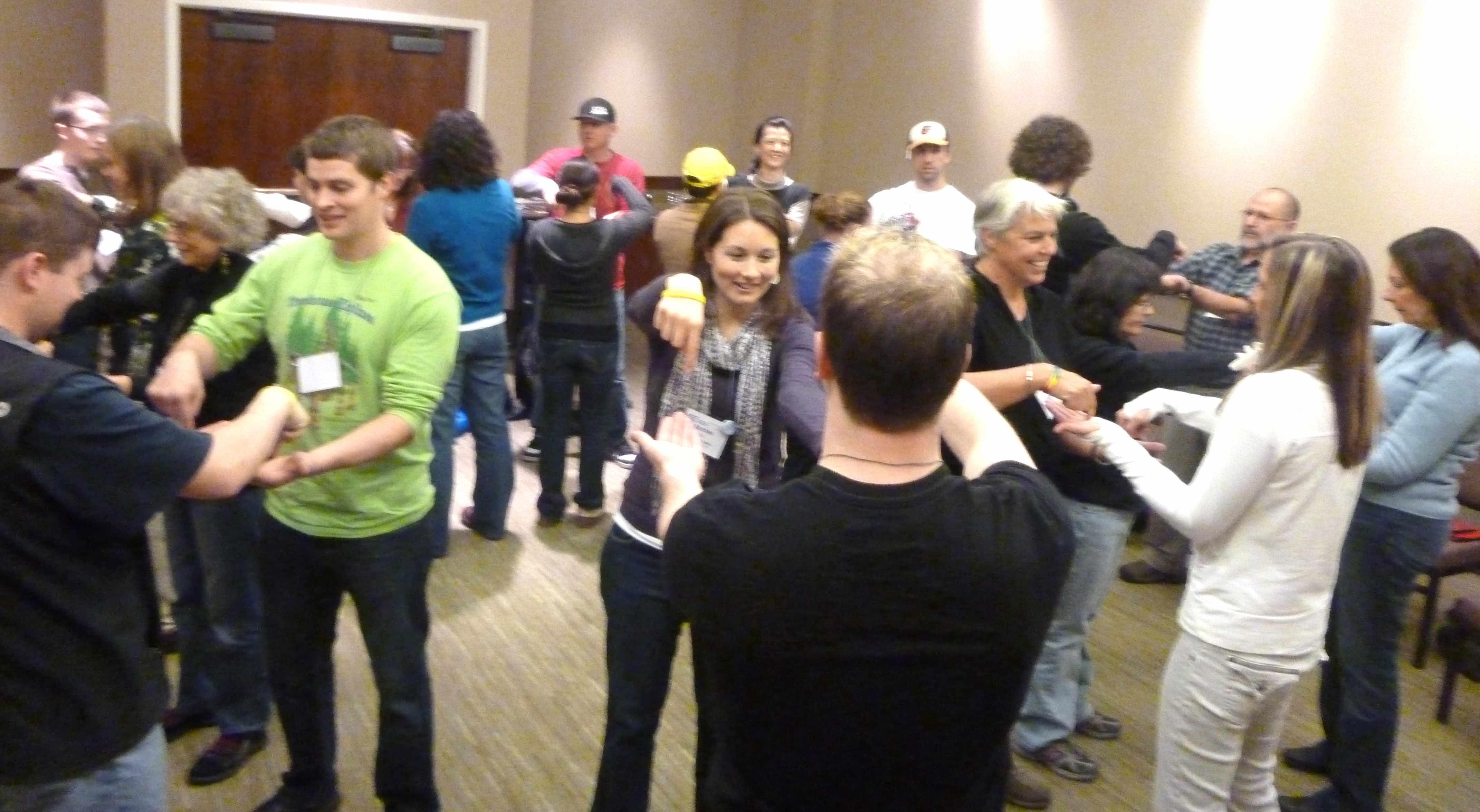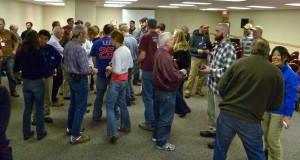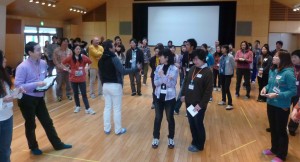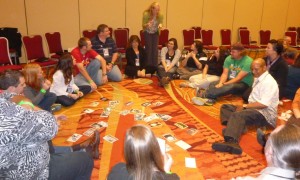
Mar 16, 2012 Large Group Facilitation Tips
In my last post I shared highlights from my recent travels to conferences throughout the U.S and Japan. I returned from these trips energized by the co-creative sharing that occurs when passionate educators come together to focus on the art of teaching and group facilitation. During these conferences I worked with some very large groups in rooms where the acoustics were challenging. This created a perfect opportunity to call upon the resources of the group to find ways to effectively share directions and manage transitions. Hence, today’s entry on tips for large group facilitation.
Attention Getters
When facilitating large groups in interactive activities it can be helpful to have some “attention-getters” so that you are not yelling at the group when leading an activity, facilitating a transition from one activity to the next or sharing directions. Many facilitators and teachers use a raised hand, hand signal, or the ubiquitous call and response method “Clap once if you can hear me, clap twice, and clap three times”.
This method can be effective, but I find many of the adult groups and middle schoolers I work with can find it patronizing. It has also been a bit overused in schools and youth programs so you sometimes see older students roll their eyes. Like in many other aspects of facilitation and teaching, mixing up your methods keeps it interesting.
I am continually learning new approaches from the groups I work with. Whenever I facilitate a large group workshop I use one of my favorite attention getters at first and then ask the group to jump in and share the techniques that have been working for them. This becomes a ongoing co-creative conversation throughout the workshop.
Here are a few favorites:
One attention getter I have been using since learning it from a participant in a 2008 AEE workshop is “A Hush Fell Over the Crowd”. The facilitator says, “A hush fell over the crowd”, and the crowd responds with husssshhh. I have been pleasantly surprised to find that the middle school students I work with particularly like this one (I think it is the shhh sound).
Another method, brought to me by a teacher last summer at the Vermont BEST Institute conference, is a simple rhythmic call and response method. She vocalizes a Chi Chi Chi Chi Cha and her group responds with Cha Cha Chi Chi Cha. Last month in my Facilitator’s Toolbox workshop at the Association for Challenge Course Technology conference Marci Charles shared that the youth in her BRIDGES Experiential Learning Center program in Memphis use step dance as a call and response attention grabber. Step Dance is a form of percussive dance popular in urban Memphis in which people use their body as an instrument, producing sounds and rhythms through a mixture of footsteps, hand claps and vocalization. Another participant in the workshop shared that they use humming. The facilitator starts and others join in. I have tried that a few times since and it has worked!
A simple and appealing visual cue that my colleague Katsumi Namba used recently in our workshops in Japan is the sign commonly used for applause by people in the deaf community. The raising of hands with outstretched fingers and twisting hands back and forth in the air.
I have found that using a combination of visual and auditory cues can be helpful to group members. It is best when the group has some ownership in creating the cue they are going to use or that it is socially or culturally relevant in some way such as the step dancing in the Bridges Program.
Please weigh in and share your favorite techniques for grabbing attention and managing transitions with large groups.






Polly Chandler
Posted at 07:43h, 17 MarchFor someone with a soft voice, this has been a lifelong challenge.
I find so many of these strategies are just annoying and noise making.
I’ve seen people with bells and that sometimes works.
I sometimes do a little tapping on the wall in a drumming pattern.
I have also found walking around the room and letting people know they have 1 minute helps.
I could use more ideas though. I like the hush fell over the room idea. I’m going to try it as I hate just making noise that can be louder than the noise of the group.
Jen
Posted at 08:36h, 17 MarchThanks for sharing your thoughts Polly. I too have found that circulating around the room and giving a time warning helps group transition from one task to the next. I find in order to successfully implement attention getters such as A Hush Fell Over the Crowd I have to walk around the room and engage a few group members at a time to initiate the progressive attention of the group. One of the things I liked about the humming method was its subtlety as the hum quietly took over the room.
Carol
Posted at 07:16h, 19 MarchI like the “A hush fell over the crowd” and the humming and chi chi chi cha cha methods and will try them in my next training.
Richard
Posted at 08:07h, 20 MarchThe “hush” method works really well and I modify it as per my surroundings such as a splash fell upon the beach.
Jen
Posted at 14:57h, 27 MarchThanks Carol for joining the conversation. I hope these ideas work for you!
Jen
Jen
Posted at 15:01h, 27 MarchThanks Richard, I love the idea of adjusting this to fit your surroundings!
John B.
Posted at 19:10h, 13 NovemberAlthough my suggestion is a variation of “clap if you can hear me,” I find it works a bit better. I change up the number of claps and then add snaps as the group begins to quiet. The snaps break up the expectation and forces the group to pay closer attention. The snaps are also quieter than the claps so they begin the process of tapering down to silence.
MaryRose
Posted at 15:01h, 17 SeptemberThis is very helpful! I’m thinking of trying a version of “making rain”: rubbing hands together to make the sound of a light rain. I may try it at my next training!